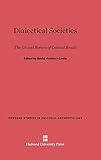Dialectical Societies : The Ge and Bororo of Central Brazil / ed. by David Maybury-Lewis.
Material type: TextSeries: Harvard Studies in Cultural Anthropology ; 1Publisher: Cambridge, MA : Harvard University Press, [2013]Copyright date: ©1979Edition: Reprint 2014Description: 1 online resource (340 p.) : 14 tables, 12 figures, 1 mapContent type:
TextSeries: Harvard Studies in Cultural Anthropology ; 1Publisher: Cambridge, MA : Harvard University Press, [2013]Copyright date: ©1979Edition: Reprint 2014Description: 1 online resource (340 p.) : 14 tables, 12 figures, 1 mapContent type: - 9780674180710
- 9780674180727
- 305.8/98/081
- online - DeGruyter
| Item type | Current library | Call number | URL | Status | Notes | Barcode | |
|---|---|---|---|---|---|---|---|
 eBook
eBook
|
Biblioteca "Angelicum" Pont. Univ. S.Tommaso d'Aquino Nuvola online | online - DeGruyter (Browse shelf(Opens below)) | Online access | Not for loan (Accesso limitato) | Accesso per gli utenti autorizzati / Access for authorized users | (dgr)9780674180727 |
Frontmatter -- ACKNOWLEDGMENTS -- CONTENTS -- FOREWORD -- INTRODUCTION -- 1. CYCLES AND TRENDS IN KRIKATI NAMING PRACTICES -- 2. THE RELATIONSHIP SYSTEM OF THE KRAHÓ -- 3. THE APINAYÉ RELATIONSHIP SYSTEM: TERMINOLOGY AND IDEOLOGY -- 4. EXIT AND VOICE IN CENTRAL BRAZIL: THE POLITICS OF FLIGHT IN KAYAPÓ SOCIETY -- 5. THE GÊ AND BORORO SOCIETIES AS DIALECTICAL SYSTEMS: A GENERAL MODEL -- 6. KINSHIP, HOUSEHOLD, AND COMMUNITY STRUCTURE AMONG THE KAYAPÓ -- 7. CULTURAL CATEGORIES OF THE CENTRAL GÊ -- 8. SELVES AND ALTERS AMONG THE EASTERN BORORO -- CONCLUSION: KINSHIP, IDEOLOGY, AND CULTURE -- REFERENCES. NOTES. INDEX -- REFERENCES -- NOTES -- INDEX
restricted access online access with authorization star
http://purl.org/coar/access_right/c_16ec
The Gê-speaking tribes of Central Brazil have always been an anomaly in the annals of anthropology; their exceedingly simple technology contrasts sharply with their highly complex sociological and ideological traditions. Dialectical Societies, the outgrowth of extended anthropological research organized by David Maybury-Lewis, at long last demystifies Gê social structure while modifying and reinterpreting some of the traditional ideas held about kinship, affiliation, and descent. Each of the seven contributors deals with a different lowland tribe, but all of them address an ideological focus on the dualistic tribal organization that is here defined as fundamental to the Gê As a collection, their work comprises a substantial revision of the hitherto undeveloped and largely ignored ethnography of Central Brazil.
Mode of access: Internet via World Wide Web.
In English.
Description based on online resource; title from PDF title page (publisher's Web site, viewed 29. Nov 2021)


